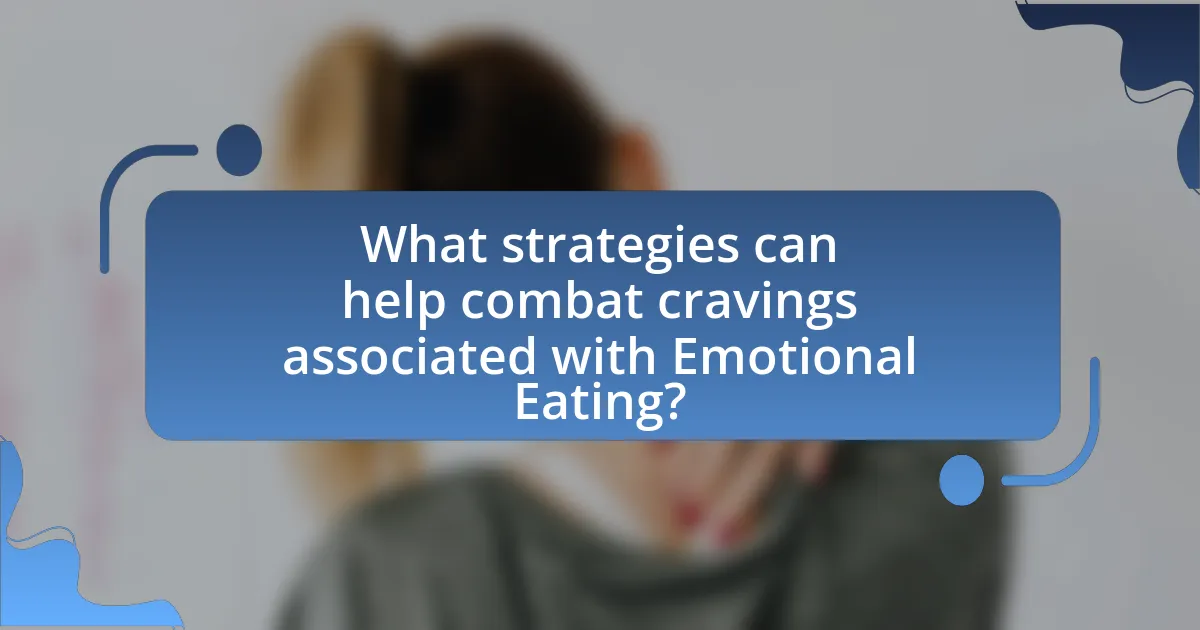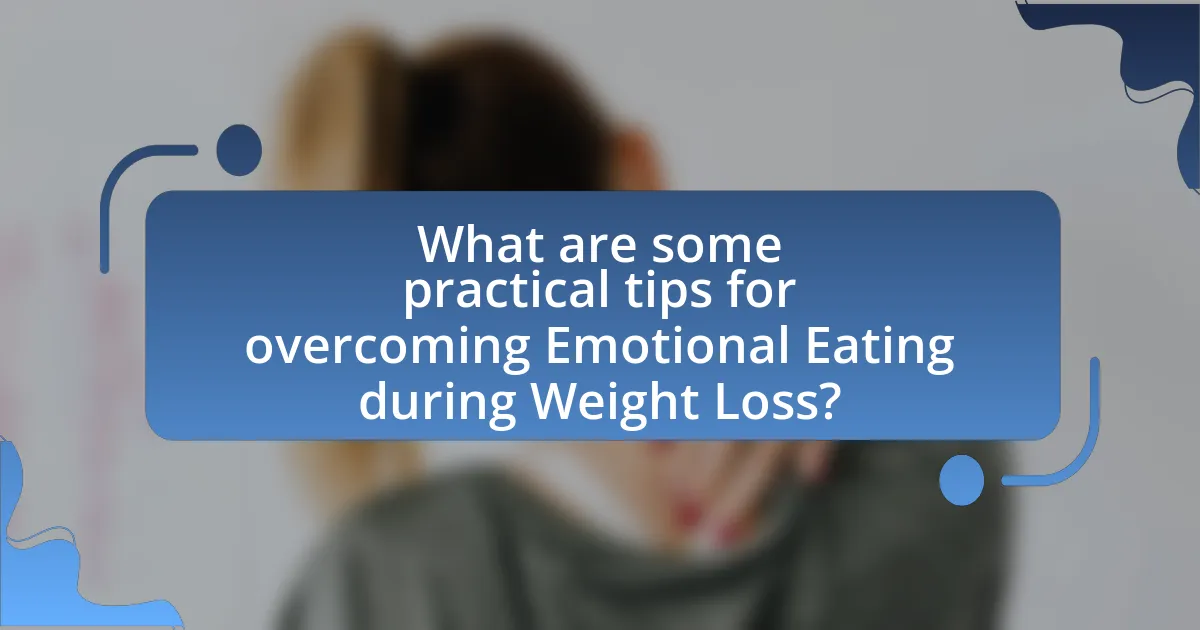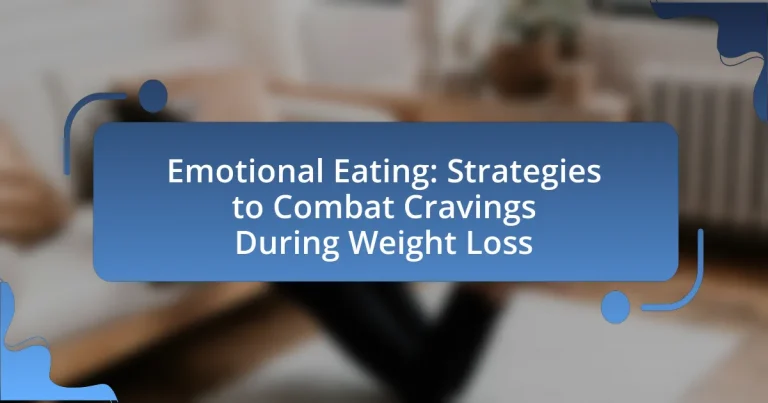Emotional eating is the practice of consuming food in response to feelings rather than hunger, often triggered by emotions such as stress, sadness, or boredom. This article explores the distinction between emotional eating and physical hunger, the psychological triggers that lead to this behavior, and its impact on weight loss efforts. It also discusses strategies to identify emotional eating patterns, the role of nutrition in managing cravings, and effective coping mechanisms such as mindfulness and journaling. Additionally, the article highlights the importance of creating a supportive environment and avoiding common pitfalls associated with emotional eating.

What is Emotional Eating?
Emotional eating is the practice of consuming food in response to feelings rather than hunger. This behavior often occurs when individuals use food as a coping mechanism to deal with emotions such as stress, sadness, or boredom. Research indicates that approximately 75% of overeating is triggered by emotional factors rather than physical hunger, highlighting the significant role emotions play in eating habits.
How does Emotional Eating differ from Physical Hunger?
Emotional eating differs from physical hunger in that emotional eating is driven by feelings and psychological states rather than the body’s physiological need for food. Physical hunger develops gradually, is characterized by a physical sensation of emptiness, and can be satisfied by a variety of foods, while emotional eating often occurs suddenly, is linked to specific emotions such as stress or sadness, and typically leads to cravings for high-calorie comfort foods. Research indicates that emotional eating can lead to overeating and weight gain, as individuals may consume food to cope with emotions rather than to satisfy hunger, highlighting the distinct motivations behind these two behaviors.
What are the psychological triggers of Emotional Eating?
The psychological triggers of emotional eating include stress, anxiety, depression, and boredom. These emotional states often lead individuals to seek comfort in food as a coping mechanism. Research indicates that stress activates the hypothalamic-pituitary-adrenal (HPA) axis, resulting in increased cortisol levels, which can enhance cravings for high-calorie foods. Additionally, individuals experiencing anxiety or depression may use food to self-soothe, creating a cycle of emotional eating that reinforces negative feelings. Boredom can also trigger emotional eating, as individuals may turn to food for stimulation or distraction.
How can one identify Emotional Eating patterns?
One can identify emotional eating patterns by recognizing specific triggers and behaviors associated with eating in response to emotions rather than hunger. Common indicators include eating in response to stress, boredom, or sadness, rather than physical hunger cues, and consuming large quantities of food in a short period, often leading to feelings of guilt or shame afterward. Research indicates that emotional eaters often report using food as a coping mechanism to deal with negative emotions, which can be validated by studies showing a correlation between emotional distress and increased food intake (e.g., a study published in the journal “Appetite” by van Strien, 2018).
Why is Emotional Eating a concern during Weight Loss?
Emotional eating is a concern during weight loss because it can undermine dietary goals and lead to weight regain. When individuals eat in response to emotions rather than hunger, they often consume high-calorie, unhealthy foods, which can sabotage their efforts to create a calorie deficit necessary for weight loss. Research indicates that emotional eaters are more likely to experience fluctuations in weight and may struggle with long-term weight management, as they often rely on food for comfort rather than addressing the underlying emotional issues. This pattern can create a cycle of guilt and further emotional eating, making it difficult to achieve sustainable weight loss.
How does Emotional Eating impact weight loss efforts?
Emotional eating negatively impacts weight loss efforts by leading individuals to consume excess calories in response to emotions rather than hunger. This behavior often results in the intake of high-calorie, low-nutrient foods, which can hinder weight loss progress. Research indicates that emotional eaters are more likely to experience weight gain and difficulty in maintaining weight loss due to the cycle of using food as a coping mechanism for stress, anxiety, or depression. A study published in the journal “Appetite” found that individuals who engage in emotional eating tend to have higher body mass indexes (BMIs) and struggle more with weight management compared to those who do not.
What are the emotional consequences of Emotional Eating?
Emotional eating leads to various emotional consequences, including increased feelings of guilt, shame, and anxiety. Individuals often use food as a coping mechanism to deal with stress or negative emotions, which can create a cycle of reliance on food for emotional relief. Research indicates that this behavior can exacerbate emotional distress, leading to a negative feedback loop where emotional eating becomes a primary response to emotional challenges. A study published in the journal “Appetite” found that individuals who engage in emotional eating are more likely to experience higher levels of depression and anxiety, reinforcing the detrimental emotional impact of this behavior.

What strategies can help combat cravings associated with Emotional Eating?
To combat cravings associated with emotional eating, individuals can implement strategies such as mindfulness, journaling, and developing alternative coping mechanisms. Mindfulness practices, including meditation and deep breathing, help increase awareness of emotional triggers and reduce impulsive eating. Journaling allows individuals to track their emotions and eating patterns, providing insights into the relationship between feelings and food choices. Additionally, developing alternative coping mechanisms, such as engaging in physical activity or pursuing hobbies, can effectively distract from cravings and address the underlying emotional issues. Research indicates that these strategies can lead to improved emotional regulation and reduced instances of emotional eating, supporting healthier eating behaviors.
How can mindfulness techniques reduce Emotional Eating?
Mindfulness techniques can reduce emotional eating by enhancing awareness of emotional triggers and promoting healthier responses to those triggers. By practicing mindfulness, individuals learn to observe their thoughts and feelings without judgment, which helps them identify the emotional states that lead to eating for comfort rather than hunger. Research indicates that mindfulness-based interventions can significantly decrease binge eating episodes and emotional eating behaviors. For instance, a study published in the journal “Appetite” found that participants who engaged in mindfulness practices reported lower levels of emotional eating and improved emotional regulation. This evidence supports the effectiveness of mindfulness in addressing the psychological aspects of eating, ultimately aiding in weight loss efforts.
What mindfulness practices are effective for managing cravings?
Mindfulness practices effective for managing cravings include mindful eating, meditation, and deep breathing exercises. Mindful eating encourages individuals to focus on the sensory experience of food, promoting awareness of hunger and satiety cues, which can reduce impulsive eating behaviors. Research published in the journal “Appetite” by Kristeller and Johnson (2005) found that participants who practiced mindful eating reported decreased cravings and improved self-regulation around food. Meditation helps cultivate a non-judgmental awareness of thoughts and feelings, allowing individuals to observe cravings without acting on them. A study in “Health Psychology” by Keng, Smoski, and Robins (2011) supports that mindfulness meditation can enhance emotional regulation and decrease the intensity of cravings. Deep breathing exercises can also help manage cravings by activating the body’s relaxation response, reducing stress that often triggers emotional eating. Overall, these mindfulness practices provide effective strategies for individuals seeking to combat cravings during weight loss.
How does mindfulness change one’s relationship with food?
Mindfulness significantly alters one’s relationship with food by fostering a heightened awareness of eating habits and emotional triggers. This practice encourages individuals to engage fully with the sensory experience of eating, allowing them to recognize hunger and satiety cues more effectively. Research indicates that mindfulness can reduce emotional eating by helping individuals identify and respond to their feelings without resorting to food as a coping mechanism. A study published in the journal “Appetite” by researchers like Kristine M. M. van Strien found that mindfulness training led to decreased binge eating and improved emotional regulation, demonstrating its effectiveness in transforming eating behaviors.
What role does nutrition play in managing Emotional Eating?
Nutrition plays a crucial role in managing emotional eating by influencing mood and satiety. A balanced diet rich in whole foods, such as fruits, vegetables, whole grains, and lean proteins, can stabilize blood sugar levels, which helps reduce cravings and emotional triggers associated with food. Research indicates that deficiencies in certain nutrients, like omega-3 fatty acids and B vitamins, can exacerbate mood disorders, leading to increased emotional eating. For instance, a study published in the journal “Nutrients” found that individuals with higher intakes of omega-3s reported lower levels of depression and anxiety, which are often linked to emotional eating behaviors. Thus, proper nutrition not only supports physical health but also plays a significant role in emotional regulation, helping individuals manage their eating habits more effectively.
Which foods can help stabilize mood and reduce cravings?
Foods that can help stabilize mood and reduce cravings include complex carbohydrates, omega-3 fatty acids, and foods rich in antioxidants. Complex carbohydrates, such as whole grains and legumes, promote serotonin production, which enhances mood and reduces cravings. Omega-3 fatty acids found in fatty fish, walnuts, and flaxseeds have been shown to improve mood and cognitive function, thereby helping to manage cravings. Additionally, foods high in antioxidants, like berries and dark chocolate, can combat oxidative stress and inflammation, which are linked to mood disorders and increased cravings. Studies indicate that a balanced diet incorporating these food types can lead to improved emotional well-being and reduced desire for unhealthy snacks.
How can meal planning prevent Emotional Eating episodes?
Meal planning can prevent emotional eating episodes by providing structure and reducing impulsive food choices. When individuals plan their meals in advance, they are less likely to turn to food for comfort during emotional distress, as they have predetermined healthy options readily available. Research indicates that structured meal planning can lead to better dietary adherence and reduced instances of emotional eating, as it encourages mindful eating practices and helps individuals recognize their emotional triggers without resorting to food.

What are some practical tips for overcoming Emotional Eating during Weight Loss?
To overcome emotional eating during weight loss, individuals should implement strategies such as identifying triggers, practicing mindful eating, and establishing a support system. Identifying triggers involves recognizing emotional states that lead to eating, allowing individuals to address feelings without turning to food. Mindful eating encourages focusing on the eating experience, which can help reduce impulsive eating behaviors. Establishing a support system, whether through friends, family, or professional counseling, provides accountability and emotional support, which can significantly reduce the likelihood of emotional eating. Research indicates that mindfulness practices can decrease emotional eating by promoting awareness and self-regulation, thus supporting weight loss efforts effectively.
How can one create a supportive environment to combat cravings?
To create a supportive environment to combat cravings, one should establish a space that minimizes triggers and promotes healthy choices. This can be achieved by removing high-calorie, unhealthy foods from the home and replacing them with nutritious options, which has been shown to reduce the likelihood of impulsive eating behaviors. Additionally, surrounding oneself with supportive individuals who encourage healthy habits can enhance motivation and accountability, as social support has been linked to better adherence to dietary changes. Creating a structured routine that includes regular meal times and planned snacks can also help manage hunger and reduce cravings, as consistent eating patterns stabilize blood sugar levels.
What changes can be made at home to minimize triggers?
To minimize triggers at home, individuals can create a structured eating environment by removing unhealthy snacks and keeping only nutritious options visible and accessible. Research indicates that the presence of tempting foods can lead to increased consumption and emotional eating, as shown in a study published in the journal “Appetite,” which found that participants were more likely to indulge in snacks that were easily reachable. Additionally, establishing regular meal times and mindful eating practices can help regulate hunger cues and reduce impulsive eating driven by emotional states.
How can social support aid in managing Emotional Eating?
Social support can significantly aid in managing emotional eating by providing individuals with encouragement, accountability, and coping strategies. Research indicates that social connections can reduce stress and improve emotional regulation, which are critical factors in preventing emotional eating episodes. For instance, a study published in the journal “Appetite” found that individuals with strong social support networks reported lower levels of emotional eating and better adherence to healthy eating patterns. This suggests that having friends or family who understand and support one’s dietary goals can lead to healthier eating behaviors and reduced reliance on food for emotional comfort.
What are some effective coping strategies for cravings?
Effective coping strategies for cravings include mindfulness techniques, distraction methods, and maintaining a balanced diet. Mindfulness techniques, such as meditation and deep breathing, help individuals become aware of their cravings without acting on them, reducing impulsive eating. Distraction methods, like engaging in physical activity or hobbies, redirect focus away from cravings, making it easier to resist them. Additionally, maintaining a balanced diet rich in protein, fiber, and healthy fats can stabilize blood sugar levels, which helps minimize cravings. Research indicates that these strategies can significantly reduce the frequency and intensity of cravings, supporting weight loss efforts.
How can journaling help in understanding Emotional Eating triggers?
Journaling can help in understanding emotional eating triggers by allowing individuals to track their thoughts, feelings, and eating behaviors over time. This practice enables a person to identify patterns and correlations between emotional states and food consumption, revealing specific triggers such as stress, boredom, or sadness. Research indicates that self-monitoring through journaling can enhance self-awareness and promote healthier coping strategies, as evidenced by a study published in the journal “Appetite,” which found that participants who kept food diaries reported greater insight into their eating habits and emotional connections to food.
What alternative activities can distract from cravings?
Engaging in physical activities such as exercise, yoga, or walking can effectively distract from cravings. Research indicates that physical activity releases endorphins, which can improve mood and reduce the desire for unhealthy foods. Additionally, hobbies like reading, painting, or gardening can redirect focus and provide a sense of fulfillment, further mitigating cravings. Studies show that mindfulness practices, including meditation and deep breathing, can also help manage cravings by promoting awareness and reducing stress, which is often a trigger for emotional eating.
What are common pitfalls to avoid when addressing Emotional Eating?
Common pitfalls to avoid when addressing emotional eating include ignoring emotional triggers, using food as a reward, and failing to develop alternative coping strategies. Ignoring emotional triggers can lead to repeated cycles of emotional eating, as individuals may not recognize the underlying feelings that prompt their cravings. Using food as a reward reinforces the association between emotions and eating, making it harder to break the habit. Additionally, failing to develop alternative coping strategies, such as mindfulness or stress management techniques, can leave individuals without effective tools to handle emotions, perpetuating the cycle of emotional eating.
How can one recognize and avoid binge eating episodes?
To recognize and avoid binge eating episodes, individuals should monitor their eating patterns and emotional triggers. Recognizing signs such as eating large quantities of food in a short time, feeling a loss of control during eating, and experiencing guilt or shame afterward can help identify binge eating. To avoid these episodes, implementing strategies like maintaining a regular meal schedule, practicing mindful eating, and addressing emotional triggers through coping mechanisms such as journaling or therapy can be effective. Research indicates that cognitive-behavioral therapy significantly reduces binge eating episodes by helping individuals develop healthier thought patterns and coping strategies.
What misconceptions about Emotional Eating should be clarified?
Emotional eating is often misunderstood as simply eating in response to emotions, but it encompasses a broader range of behaviors and triggers. One misconception is that emotional eating only occurs during negative emotions; in reality, people may also eat in response to positive emotions, such as celebrations or rewards. Another misconception is that emotional eating is solely about lack of willpower; research indicates that it can be influenced by psychological factors, including stress and anxiety, which can lead to cravings for high-calorie comfort foods. Additionally, many believe that emotional eating is always harmful, but it can serve as a coping mechanism for some individuals, providing temporary relief from emotional distress. Understanding these nuances is essential for developing effective strategies to manage cravings during weight loss.


